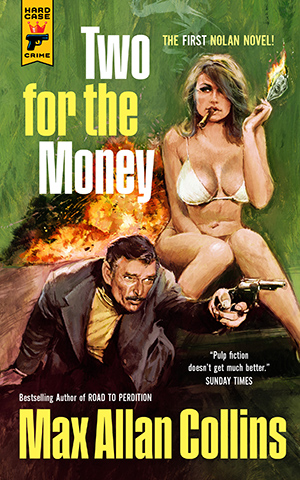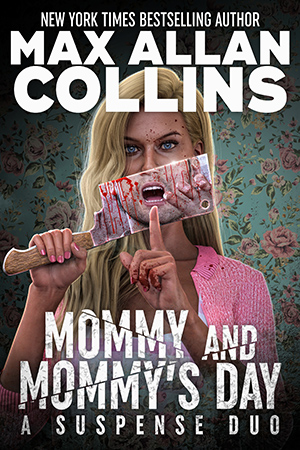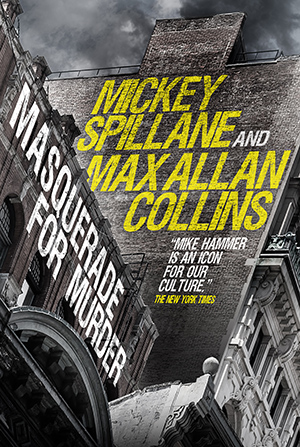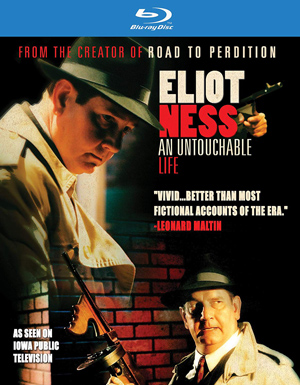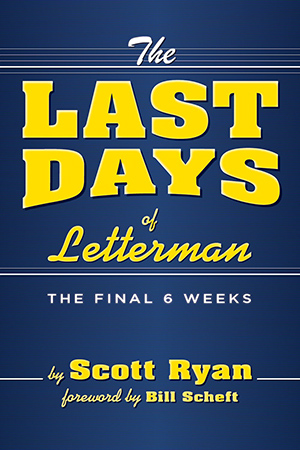This book giveaway may be my biggest yet.
I am offering ten copies each of Kiss Her Goodbye, Shoot-out at Sugar Creek, Two for the Money – these are all books that will be published in April.
Kiss Her Goodbye is a trade paperback from Titan of the third Spillane/Collins Mike Hammer novel, with my original, previously censored ending.
Shoot-out at Sugar Creek is the final Caleb York western being published by Kensington, although I hope to revive the series next year (probably with Wolfpack). This edition is a trade paperback the size of the hardcover and is an advance reading copy.
Two for the Money is a reprint of Hard Case Crime’s omnibus of the first two Nolan novels, Bait Money and Blood Money, with a new cover (the previous one being the rare HCC cover that disappointed).
[All copies have been claimed. Thank you for your support!–Nate]
You agree to write a review for Amazon and/or Barnes & Noble (and other review sites, blogs, etc.). This is the honor system, but Big Brother is watching. Or anyway I am.
Kiss Her Goodbye will be of interest to Mike Hammer fans because this is indeed the correct ending for the novel. My previous editor objected to what he considered too big a similarity to the ending of a classic Spillane title; he is a Spillane fan and expert, and I mean no disrespect to him – he was instrumental in getting Mike Hammer back out there – but I should not have given in to him and rewritten it.
So if you already have the hardcover, you still need to get the trade paperback. Yes, it’s double dipping, but there’s a new cherry on the sundae.
Barb and I are doing a Master Class via Zoom that is available to anyone interested.
DSM Book Festival: Sat. April 3
Workshop: Max Allan Collins at 9 a.m. (duration 1 hour)
Log-in: 8:40 a.m.
Workshop description:
Learn from the masters, Max Allan Collins and his wife Barbara Collins, as they each present their Top 5 Fiction Writing Tips and then field questions from the class. Together, Max and Barb have published the “Trash & Treasures” mystery series. Max is the New York Times bestselling and award-winning author of “Road to Perdition”, “True Detective,” the Quarry series, “Girl Can’t Help It” and many more.
Here’s the link: https://www.dsmpartnership.com/dsmbookfestival/attend/writers-workshops
They are taking registrations for until March 30.
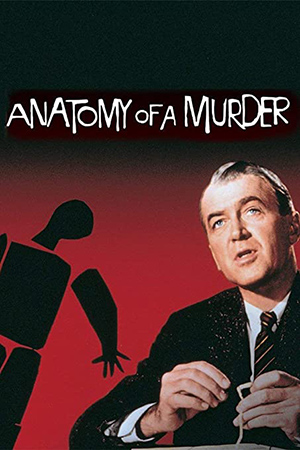
Several classic films got watched around the Collins household this weekend.
First, one of my top ten turned up in high-def on TCM – Anatomy of a Murder. I watch this once a year, and am astonished by how caught up in it I get every time. It’s a perfect movie. Otto Preminger may have been a cruel taskmaster, but he made some great films (Anatomy the greatest, but Laura and Advice and Consent ain’t chopped liver, nor are a bunch of other films noir, and he pushed the censor’s envelope with Moon Is Blue and Man With a Golden Arm) (on the other hand…Skidoo).
James Stewart is at the top of his powers in Anatomy, and I am reminded that he was the greatest film actor of the 20th Century. That sounds like I’m stating a fact. I am. No one starred in, and propelled, more great films than Stewart. If you can top this list with your choice, feel free to try – Mr. Smith Goes to Washington, The Shop Around the Corner, The Philadelphia Story, It’s a Wonderful Life, Winchester ‘73, Harvey, Rear Window, Vertigo, Anatomy of a Murder, The Man Who Shot Liberty Valance).
And that’s just the great films. It doesn’t count the really good ones, like the other Anthony Mann films he made, or Bell, Book and Candle, or Rope, or Destry Rides Again, or The Man Who Knew Too Much, or Flight of the Phoenix, or The Shootist.
He made Vertigo, Bell, Book and Candle and Anatomy of a Murder right in a row – astounding. On my birthday Barb and I watched Vertigo in 4K in case I’d forgotten that it was my favorite movie. I would hate to have to choose between Vertigo and Anatomy of a Murder for Stewart’s best performance, and they are quite different, at that.
I love courtroom dramas and Anatomy is the best I’ve ever seen. It’s based on a novel by a lawyer (Robert Traver) and was itself based on a real murder case that lawyer won as a defense attorney. Boldly shot entirely on location, the film has a stunning, innovative jazz score by Duke Ellington and amazing opening credits by Saul Bass. For its day it was daring in its subject matter and frank expression thereof.
But perhaps what dazzles me most, every time I see it, is the intersection of two eras – Stewart as a Golden Age movie star going head to head with the Method crowd of Ben Gazzara, George C. Scott and Lee Remick. Gazzara and Remick are terrific in it, and Scott too…but Stewart owns the picture anyway. He is aided and abetted by two classic Hollywood supporting players – Eve Arden and Arthur O’Connell.
Two supporting performances stand out for me – Orson Bean, a personal favorite of mine (for The Star Wagon if nothing else), and Joseph Welch, Joe McCarthy’s real-life nemesis who, though an amateur actor, more than holds his own in this heady company.
Interestingly, another supporting player – Russ Brown – turned up in the second half of our amazing double feature this weekend – Damn Yankees (1958), on Blu-ray at last. Brown played the trainer of the Washington Senators in the great Broadway hit brought very faithfully to the screen by George Abbott and Stanley Donen. In the original show, Brown won a Tony as did Gwen Verdon and Ray Walston, and choreographer Bob Fosse.
Damn Yankees is one of the handful of Broadway musicals done justice by Hollywood – others include Li’l Abner, Pajama Game and How to Succeed in Business Without Really Trying. Pajama Game was based on the novel 7 ½ Cents by Iowa novelist Richard Bissell (another personal favorite). Both Pajama Game and Damn Yankees (also from a novel, Douglas Wallop’s The Year the Yankees Lost the Pennant) had scores by Richard Adler and Jerry Ross, but tragically Ross died at age 29, leaving only these two great shows and a few pop songs as a nonetheless amazing legacy for the team.
The films of Damn Yankees and Pajama Game brought almost the entire Broadway casts along for the ride. Pajama Game replaced Janis Paige with Doris Day and Damn Yankees replaced Robert Shafer with Tab Hunter. Hunter gets a bad rap, sometimes, for his performance, but he’s quite good.
While I’m ruminating about (not quite reviewing) films I’ve seen recently, I should mention Zack Snyder’s Justice League, which lasts four hours plus and is streaming on HBO Max. This is an odd duck of a movie for many reasons. Director/writer Snyder left the original filming due to a family tragedy and Joss Whedon took over. Fans largely recoiled at Whedon’s version, which took a somewhat light approach to what had been conceived as a dark film. He re-shot most of it. I’ve often liked Whedon’s work, but his Justice League only looks good if you compare it to Wonder Woman 1984.
Snyder restored the material Whedon either cut or ignored of a film Snyder had shot 80% of, albeit minus most special effects. Fan pressure, amazingly, got Snyder the opportunity (i.e., the funding) to complete the film his way, and it’s better. Obviously over-long, but on its own quirky terms, it’s a super-hero epic worth seeing.
But quirky is right – for one thing, he presents the film in 4:3 ratio, which is to say, old-fashioned square TV format, apparently because that’s the I-Max format, even though not much of the film had been shot that way. Oh-kay….
And he got most of the cast back to film an apocalyptic dream sequence that ruins an otherwise acceptable epilogue. The dream sequence features ridiculously misjudged dialogue between Ben Affleck’s Batman and Jared Leto’s Joker (otherwise not in the film). How ridiculous? Batman talks about “fucking killing” Harley Quinn, and the Joker rhapsodizes about giving Batman a “reach-around.” Plus, it lasts a long time, right after we’ve sat through about four hours of capes and quips. Not okay.
Curiously, the film goes out of its way to set up the next film in the saga that Snyder would have made had Warner’s and DC not cancelled it. So rather than take the opportunity to bring his saga to a satisfying conclusion, Snyder tosses loose ends right and left, as if daring somebody to give him more money to keep going.
Nonetheless, I enjoyed it. I took the ride. I just wish I had turned it off when the dream sequence (initially not obviously a dream sequence, more a flash-forward) (including the Flash) gave a bad taste to a good time.
Here’s an interview I did with Brian Vakulskas on KSCJ radio in Sioux City, largely about the current Nolan novel, Skim Deep. The interviewer knew his stuff.
And here’s an advance look at the third Ms. Tree collection from Titan.
M.A.C.
